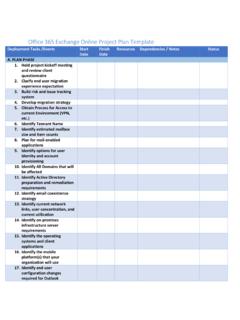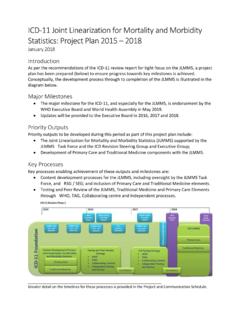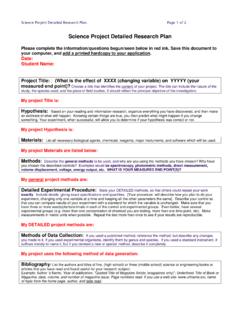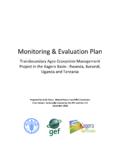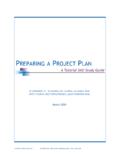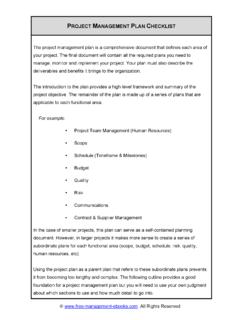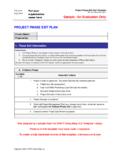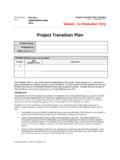Transcription of Risk Management Plan <Project Title> - Kentish …
1 Risk Management plan < project title > Risk Management plan This document has been derived from a template prepared by the Department of Premier and Cabinet, Tasmania. The structure is based on a number of methodologies as described in the Tasmanian Government project Management Guidelines. For further details, refer to Table of Contents 1 Executive 4 2 Introduction .. 4 3 Risk Assessment .. 5 Identification .. 5 Analysis and Evaluation .. 6 4 Risk Mitigation .. 8 5 Risk Monitoring .. 9 6 Roles and Responsibilities .. 9 Steering Committee .. 9 project Manager .. 9 project Team .. 10 Appendix A: < project title > Risk Register (as at dd/mm/yy).
2 11 < project title > project - Risk Management plan 1 Executive Summary The purpose of this document is to provide a Management framework to ensure that levels of risk and uncertainty are properly managed for the remainder of the project . As risk Management is an ongoing process over the life of a project , the Risk Register must be considered a snap shot of relevant risks at one point in time. This document will achieve this by defining the following: the process that will be/has been adopted by the project to identify, analyse and evaluate risks during the remainder of the project ; how risk mitigation strategies will be developed and deployed to reduce the likelihood and/or impact of risks ; how often risks will be reviewed, the process for review and who will be involved; roles and responsibilities for risk Management ; how reporting on risk status, and changes to risk status, will be undertaken within the project and to the Steering Committee.
3 A complete Risk Register containing all risks identified for the project , their current gradings and the identified risk mitigation strategies to reduce the likelihood and seriousness of each risk. 2 Introduction The purpose of risk Management is to ensure levels of risk and uncertainty are identified and then properly managed in a structured way, so any potential threat to the delivery of outputs (level of resourcing, time, cost and quality) and the realisation of outcomes/benefits by the Business Owner(s) is appropriately managed to ensure the project is completed successfully. The objectives of the risk Management approach in the < project title > project are to identify, assess and mitigate risks where possible and to continually monitor risks throughout the remainder of the project as other risks or threats emerge or a risk s impact or likelihood changes.
4 As risk Management is an ongoing process over the life of a project , this Risk Management plan and Risk Register must be considered a snap shot of relevant risks at one point in time. Where required, the process of risk identification, assessment and the development of countermeasures will involve consultation with the Steering Committee members, the < project title > Reference Group, other relevant stakeholders and project team members. < project title > project - Risk Management plan 3 Risk Assessment Identification Risk identification involves determining which risks or threats are likely to affect the project . It involves the identification of risks or threats that may lead to project outputs being delayed or reduced, outlays being advanced or increased and/or output quality (fitness for purpose) being reduced or compromised.
5 For most large/complex projects, a number of high level risks should have been identified during the project initiation stage these should be used as the basis for a more thorough analysis of the risks facing the project . One of the most difficult things is ensuring that all major risks are identified. A useful way of identifying relevant risks is defining causal categories under which risks might be identified. For example, corporate risks , business risks , project risks and infrastructure risks . These can be broken down even further into categories such as environmental, economic, political, human, etc. Another way is to categorise in terms of risks external to the project and those that are internal.
6 See the project Management Risk Identification Tool for some useful prompts in identifying project risks . The Australian Standard for Risk Management AS/NZS 4360: 2004 Appendix D refers to generic sources of risk. The wording or articulation of each risk should follow a simple two-step approach: 1. Consider what might be a trigger event or threat (eg. poor quality materials causes costs to rise ) several triggers may reveal the same inherent risk; then 2. Identify the risk - use a newspaper headline style statement short, sharp and snappy (eg. budget blow out ) then describe the nature of the risk and the impact on the project if the risk is not mitigated or managed (eg.)
7 project delayed or abandoned, expenditure to date wasted, outcomes not realised, government embarrassed etc). Use the Risk Register (see Appendix A) to document the results. For large or complex projects it can be beneficial to use an outside facilitator to conduct a number of meetings or brainstorming sessions involving (as a minimum) the project Manager, project Team members, Steering Committee members and external key stakeholders. Preparation may include an environmental scan, seeking views of key stakeholders etc. For a small project , the project Manager may develop the Risk Register perhaps with input from the project Sponsor/Senior Manager and colleagues, or a small group of key stakeholders.
8 It is very easy to identify a range of risks that are outside the project and are actually risks to the business area during output delivery, transition or once operational mode has been established. These are not project risks and should not be included in the project Risk Register, but referred to the relevant Business Owner. It may be appropriate to submit an Issues Paper to the Steering Committee recommending formal acceptance by the relevant Business Owner for ongoing monitoring and Management of specific risks . < project title > project - Risk Management plan See the project Management Fact Sheet: Developing a Risk Management plan and the Risk Identification Tool for more information on how to undertake risk identification.
9 In this section specify: what risk identification process has been undertaken (ie. brainstorm, facilitated session, scan by project Manager etc); any categories used to assist in the identification or relevant risks ; when the risk identification process occurred; and who was involved. Analysis and Evaluation Once risks have been identified they must be analysed by determining how they might affect the success of the project . Generally the impact of a risk will realise one or any combination of the following consequences: project outcomes (benefits) are delayed or reduced; project output quality is reduced; Timeframes are extended; Costs are increased.
10 Once analysed, risks should be evaluated to determine the likelihood of a risk or threat being realised and the seriousness, or impact, should the risk occur. 'Likelihood' is a qualitative measure of probability to express the strength of our belief that the threat will emerge (generally ranked as Low (L), Medium (M) or High (H)). 'Seriousness' is a qualitative measure of negative impact to convey the overall loss of value from a project if the threat emerges, based on the extent of the damage (generally ranked as Low (L), Medium (M), High (H) or Extreme). From this risks will be graded as A, B, C, D or N according to the following matrix: Likelihood Seriousness Low Medium High EXTREME Low N D C A Medium D C B A High C B A A The ratings for likelihood and seriousness determine a current grading for each risk that in turn provides a measure of the project risk exposure at the time of the evaluation.


